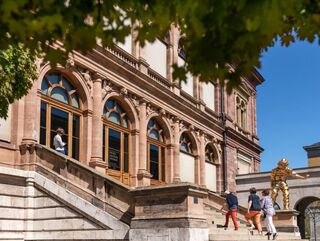Museum Neues Weimar/ New Weimar

The History
The Grand Ducal Museum was opened in 1869 in one of the first German purpose-built museum buildings. The Czech architect Josef Zítek designed the domed central wing in neo-Renaissance style. The side risalits are covered by tented glass roofs. It was a venue for path- blazing exhibitions of contemporary art in the early 1920s.
After standing vacant for 50 years, the then so-called Landesmuseum had deteriorated to an almost complete ruin by 1989, due to severe damage during WWII and subsequent neglect. It was refurbished to its original appearance and augmented with modern museum technology for the Cultural City of Europe year in 1999.
Up until 2004, the museum exhibited works of the international avant-garde from the Paul Maenz collection. Presently, temporary exhibitions are shown. Whit the Bauhaus Museum Weimar, the Museum Neues Weimar next door focuses on the pioneers of Modernism such as Henry van de Velde, Count Harry Kessler and Friedrich Nietzsche.
Information
Opening hours
General opening hours
till April 13th: Fri - Sun | 9.30 am - 6.00 pm
from April 14th to October 30th: Wed - Mon | 9.30 am - 6.00 pm
closed on Tuesdays
Bus: Goetheplatz alle Linien, Wegstrecke 350 m
Parken: Gebäuderückseite öffentlicher Parkraum Rathenauplatz
Behindertenparkplätze: Tiefgarage im Atrium über Weimarplatz Wegstrecke 170 m, 6x Parkdeck 1, 4x Parkdeck 2 (210 cm Einfahrthöhe!), Kassenautomat Bedienfeldhöhe 140 cm über Aufzug / Lift am Weimarplatz: Brandschutztür mit 2 cm Schwelle und 105 cm breit, Aufzugtür 108 cm breit, Kabine 220x130 cm, Handlauf 80 cm hoch, Tastatur 80 cm hoch, Schrift erhaben und Brailleschrift, Lichtsignal
Menschen mit Sehbehinderung / Hörbehinderung: Assistenzhunde eingeschränkt erlaubt, mobile Hörschleife zur Nutzung der Audioführung, auf Anfrage spezielle Führungen für seh- oder hörbehinderte Gäste
Eingang: Treppenportal mit 20 Steinstufen ohne Handlauf, Podest nach 7 Stufen
Menschen mit Mobilitätseinschränkung: Kopfsteinpflaster im Außenbereich des Museums
Seiteneingang ohne Schwelle im EG: Gebäuderückseite Eingangstür 100 cm breit, Glasautomatiktür 90 cm breit mit Gegensprechanlage zum Aufzug / Lift: Taster 100 cm hoch, Türöffnung 85 cm, Kabinentiefe 150 cm, Kabinenbreite 140 cm, Tastatur 105 cm hoch, Ton- und Lichtsignal
Information, Shop und Kasse im OG: Counter / Tresenhöhe 100 cm mit dem Rollstuhl links am Aufzug über Ausstellungsräume zur Kasse
Behinderten-WC im EG: Türgriff 100 cm hoch, Tür
90 cm breit, Bewegungsfläche
100x200 cm, WC 45 cm hoch, WC 60 cm tief, und Sensorspülung, Haltegriffe beidseitig mit Zwischenabstand 67 cm, links fest, rechts klappbar mit Bewegungsfläche
90 cm, Waschbeckenhöhe
85 cm unterfahrbar, Notrufklingel rechts
Begriffserklärung:
EG-Erdgeschoss
OG-Obergeschoss
Anzeigen